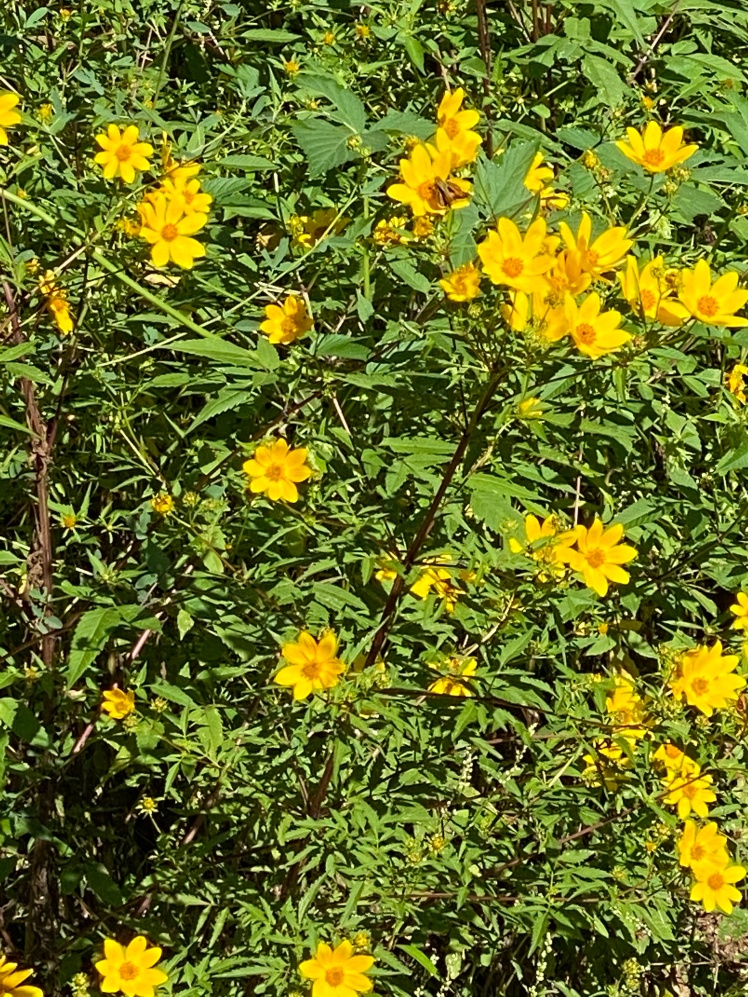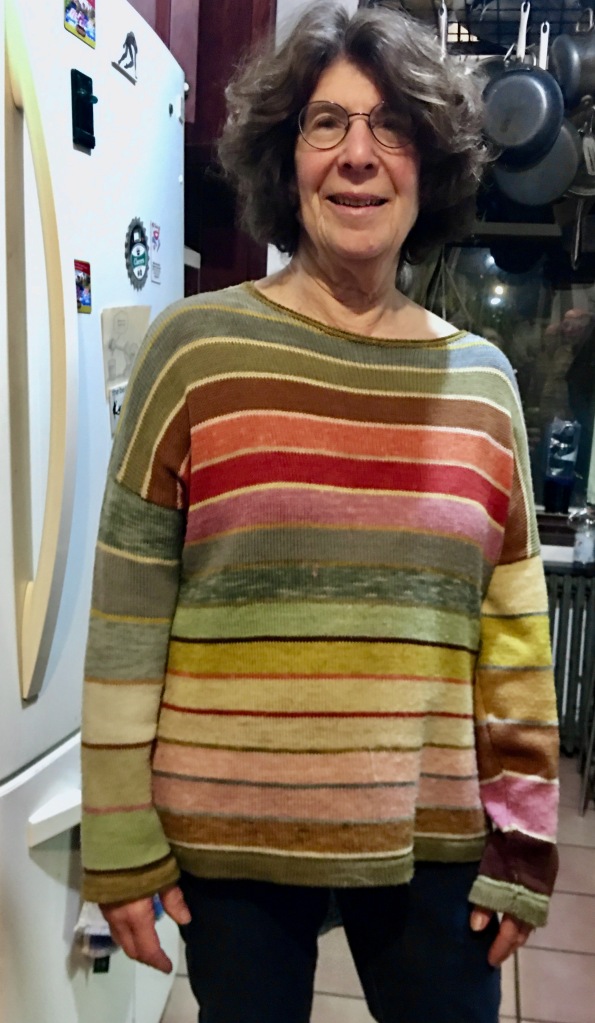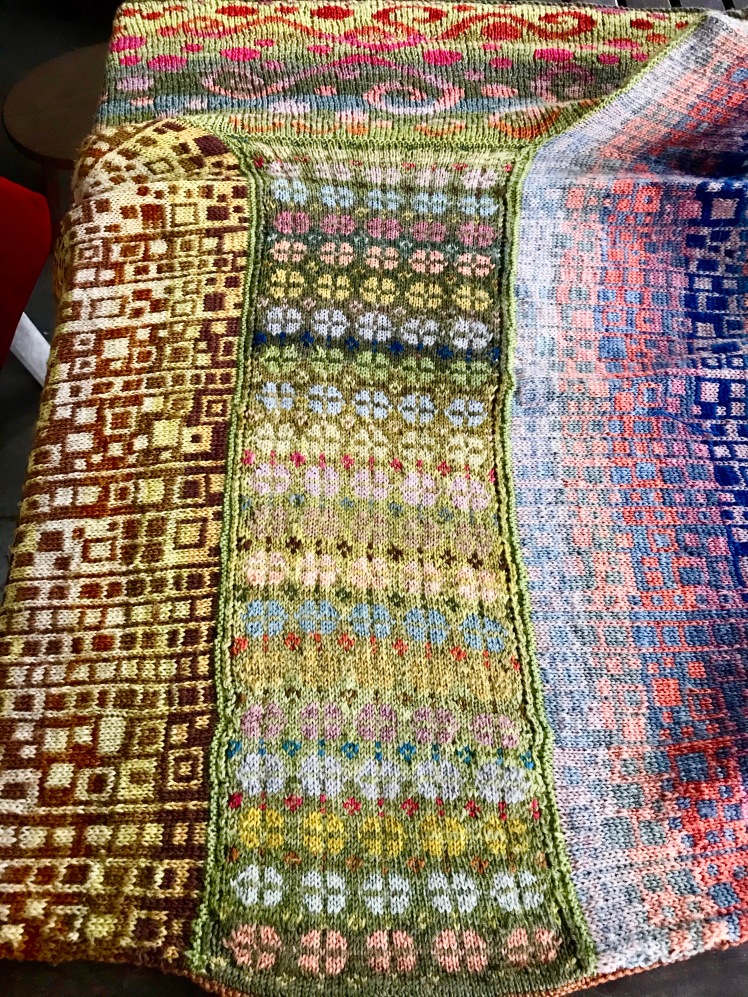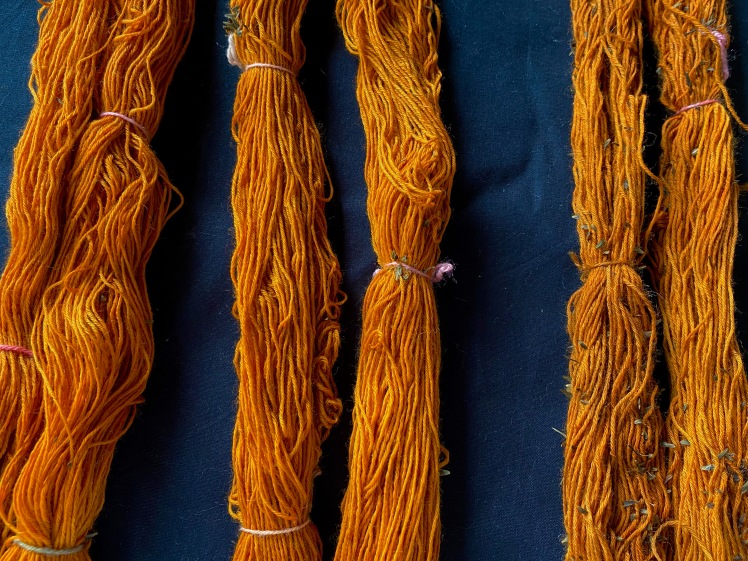In the last month, I have dyed a wide range of yellows, oranges, and pinks, using plants that grow wild in the park at the end of my short little street. This summer I learned about using an afterbath of baking soda dissolved in tap water at a pH of 8 to 9, and it got me brilliant oranges, after dyeing with coreopsis, and a variety of greens from black-eyed susans. I was very eager to see how it would behave with Jerusalem artichokes, which I discovered last year growing abundantly in a marshy area near a retention pond and the stream that flows through the park, and which produced a rich yellow. I spent this summer watching the places where I found them last year, and they didn’t appear. But in early September I found other yellow flowers whose blossoms looked a lot like Jerusalem artichokes, but the plant was smaller, the leaves were different, and the shape of the petals was shorter and wider.
When they started blooming in numerous places, I took a few blossoms from each place for a small bath of the several ounces of plant material that I collected. I poured boiling water on the blossoms and let the bath sit overnight, then added two 2-ounce hanks of superwash wool that had been mordanted in alum and cream of tartar, and got a bright light yellow on them. I kept one as-is and put the other in the baking soda afterbath, and it turned a gratifying medium orange.

I still don’t have a positive identification of what exactly this plant is, but it appears to be a member of the Bidens genus, related to common beggar’s tick, which grow profusely in the areas where I walk. The leaves are exactly the same, but the common beggar’s tick blossoms don’t have petals, and it’s not that the petals fell off the plants when I wasn’t looking, because I had been looking, very, very closely.

Several years ago I was experimenting with color extraction by fermenting plants. I put up vat after vat of pokeberries, and it produced an amazing royal purple. Alas, the yarn was no longer amazing or royal purple a year or so later. It faded to a dusty mauve, which isn’t a bad color. I used the vivid purple in a sweater for my sister a couple of years ago, and a year later the purple had faded to mauve. But the faded color looks more compatible with the rest of the natural colors in the sweater, so I accept the change and am wiser for the experience.
Here’s the “before”:

And “after”, taking into account the way indoor, nighttime, artificial lighting dulls colors.

I used the faded color in my Johanna’s Jacket last spring in a couple of places, a lighter version of the color in a pink gradient sequence contrasted with a blue gradient and a darker version in a gradient next to a madder red, contrasted with a light yellow-green, so that if the color faded further, there would still be plenty of contrast. I also used it with a green of about the same value, because I wanted to have a low-contrast sequence for the purposes of my design, and because I was pretty confident that it wasn’t going to fade further. I think that’s the trick to using a color that is prone to fading– use it in a block where it can change into whatever it wants to change to without making the design unintelligible, or make sure there’s plenty of contrast with the colors next to it if it’s used in patterning. But after discovering that fermentation didn’t make the color stable, as I was hoping, I stopped dyeing with pokeberry.


However, someone on my Ravelry group showed photos of pinks that she had gotten from pokeberries in a vinegar bath, and she said her colors were pretty stable. So I got a couple of gallons of white vinegar and waited for the pokeberries to ripen so that I could stuff them into an old tomato juice jug and cover them with vinegar. I let the bath sit for a couple of weeks, then poured off enough of the liquor to cover a 2-ounce hank of yarn that I had mordanted in alum and cream of tartar and left it in the bath for a day, then put another 2-ounce hank in the exhaust and left it for a day. The first dyeing was a deep pink, and the exhaust was a light, clear pink. I still had a good bit of this liquor left, so I played with temperature and alkaline modifier to see if I could get different shades from the dye. I had been told that gentle, carefully applied heat would shift the color toward red, and alkaline modifier would shift it toward purple. I very tentatively heated the dye toward steaming, with a hank of yarn in the pot, and very little happened. The color got a bit browner, not redder, so I took the bath off the heat before the desirable pink color was completely destroyed. Then I poured some of the liquor into a cup and put a bit of baking powder into it. It fizzed madly as I stirred, which was not good sign. It meant that the vinegar of the bath, an acid, and the alkaline baking soda were neutralizing each other. When I put a test strand of the dyed yarn into a solution of baking powder and water, the previously pink strand leached to white after a couple of hours. So maybe there’s a way to shift the color with heat and alkaline modifier, but I haven’t found it, not with this pokeberry/vinegar dye extraction method.
I have a range of intensities of pretty much the same hue of pink, from pastel pink with blue undertones to darker pinks. I just started a new bath with the idea of getting something closer to magenta by repeatedly dyeing and drying the same hank, since repeated dyeings will intensify a color. If this method produces a reasonably stable color, I will be thrilled to have found a way to get pinks using a ubiquitous invasive plant rather than ordering powdered cochineal, for which living insects in South America had to die, from a dye supply company.

On my walks along the wooded path above the stream that flows through the park near my house, I noticed masses of plants with little orange flowers. When I plucked one of the flowers and squeezed it between my fingers, it turned my fingers a bright orange. I posted a picture and asked for an identification on a Ravelry plant dyeing group, and was told that the plant was jewelweed and it dyes yellow and orange. And I didn’t have to sort out the flowers from the rest of the plant in order to get color from it, I could use the entire plant. Next day I picked a few ounces, heated it in a steaming bath for an hour or so, and dyed two alum-mordanted 1.5 ounce hanks and got a light yellow-orange. I kept one as-is and put the other in a baking soda afterbath, and the color shifted to a bright yellow. There’s still plenty of jewelweed out there, so I should see if I get a more intense orange with a bath with more plant material in it.

But in the meantime, I’ve been busy with the common beggar’s tick that I mentioned earlier, after seeing a blog post by a dyer/weaver in the UK that showed a rust red, exactly like a madder red, that resulted from a heat-extracted bath and an alkaline afterbath. Madder red without the madder? I went right out and cut off a bag full of common beggar’s tick and cooked it up. Then I put a test strand into the bath and it turned a dark ochre after a couple of hours. After about 24 hours in a water and baking soda solution, it darkened and reddened until it looked almost like that madder red. I put two 1.5 ounce hanks into the bath, and it stayed there for a couple of days, but it didn’t get as dark as the test strand, more like a complicated dark yellow. Then they spent several days in a baking soda afterbath at about pH 8.5. They got to a dark pumpkin orange after about a day and stayed there. I like dark pumpkin orange, no complaints here, but I was still curious about whether madder red was possible with the plants available to me using the method I use. So I collected a bigger bag of common beggar’s tick and simmered it for a while, then added a single hank weighing 1.4 ounces and let it stay there for two days, until it got to that dark ochre of the test strand, then several days in the alkaline bath. It got darker than the first two hanks, but it’s not a madder red. It’s a deeper intensity of the pumpkin orange of the first attempt. I don’t think I have another color like it, so I’m happy. Annoyingly, I can’t seem to get a photograph of these colors that shows that this hank is a shade or two darker in real life than the first two.

I was curious about what would happen if I put a strong yellow into a pink pokeberry exhaust bath. The bidens flowers were still blooming, but now the Jerusalem artichokes were out in force as well, so I picked a mixed bag of the blossoms of both plants, about 4.5 ounces. Same extraction method as before– a pot of boiling water dumped over the blossoms, let it sit overnight. I put in two 1.5 hanks and they got to a nice strong yellow. I let one stay yellow and I put the other one into a pokeberry exhaust bath. It turned a muddy yellowish orangish color, but mostly it was muddy. I rued the loss of my pretty yellow, but now I know not to try that again. The color can be used in a gradient bridging yellow and orange. It can also work as a background color in the project I show below.

Now I have this wonderful range of pinks, yellows, and oranges. I’m pretty sure the yellow and orange colors are stable, but I don’t know about the pokeberry pinks. I have some confidence that whatever they might change to, they are very likely to retain some color, since the unmordanted yarn I dyed using fermented pokeberries shifted from vivid royal purple to dusty mauve and seems not to be fading further. The yarn I’m dying with pokeberries in a vinegar bath has been mordanted in alum and cream of tartar, which usually is effective in brightening and stabilizing plant dye colors, so maybe that will improve the chances for a long life for the pinks. The important thing is that they not fade into unintelligibility. As long as there’s something there, they can do what nature tells them they must do. My job is to put these colors in situations where their changes support my design, regardless of what the changes are.

Until I find out how colorfast the deeper shades of pink are, I will probably use the lighter shades more. One of my current WIPs (works in progress) is a stranded project that pairs dark yarns with lighter background colors in a pattern based on the shapes of ironwork fencing. The ironwork is delineated in blues, greens, and browns that have proven to hold their color over time, and I’m arranging the lighter colors in stripes and gradients. The main thing I care about is that there’s plenty of contrast between the two colors so that the patterning reads. The pale pink will look pretty against the blues, greens, and browns, but if it turns beige or gray, the patterning will still read. I would like to use the deeper pinks later on in the project, contrasted with green, but if I do, it will be against the very palest of my greens. Probably the best way to use the deep pinks while they’re still on probation would be in stripes, as in the sweater I knitted for my sister. As long as the neighboring colors come from plants, the colors of the stripes will be compatible no matter how they change.


What a great post. I do not dye yarn, but I so admire the scientist and naturalist in you!! I love each and every one of those colors!
LikeLiked by 1 person
Thank you so much! Real scientists would cringe at my sloppiness, but I do have fun!
LikeLiked by 1 person
So for the alkaline modifier with the poke, would an after-bath react the same way and still neutralize the vinegar, think you?
LikeLike
When I put the pink test strand into the alkaline afterbath, it lost all of its color. So yes, it neutralized the acid-based color into nothingness.
LikeLike
😦 Shame. I have a batch fermenting now, (plain water and poke), and I’m waiting to see what “mordanting” the yarn in vinegar 1st ‘a la Carol Lee’ does. I love the sound of your WIP design, and I hope you’ll share pictures with us when it’s complete!
LikeLiked by 1 person
Please let me know how it comes out! I’m very interested in ways to extract color from pokeberry that will hold up over time.
LikeLike
All I have to say is wow!… I play with natural dye and you have shown me that I have so much more to learn… loved this post!
LikeLiked by 1 person
I’m glad my story about my experiments was helpful to you!
LikeLiked by 1 person
I’m very impressed by the processes you use and the works you produce. Thanks for the detailed posts.
LikeLiked by 1 person
Thanks so much!
LikeLike
I admire your continuing work in natural dyes, and enjoy seeing what you accomplish with them. I don’t know whether you’ve explored lichen dyes (I’m not a dyer myself), but I ran across this intro via my Twitter feed today and thought I’d forward the link in case you haven’t seen it. There’s quite a neon yellow sample. https://www.fungimag.com/summer-2014-articles/LR2%20V7I2%2066-69%20Dies.pdf
LikeLike
I have tried to dye with lichen but have only experienced miserable failure with them. 😢😭😞😫
LikeLike